

Manufacturer's Specifications:
FM Tuner Section
Usable Sensitivity: Mono, 10.8 dBf, 1 .9 µV.
50-dB Quieting: Mono, 13.7 dBf, 2.7µV; stereo, 37.2 dBf, 39.7 µV.
S/N: Mono, 75 dB; stereo, 70 dB.
THD: Mono, 0.15 percent at 1 kHz and 100 Hz, 0.3 percent at 6 kHz; stereo, 0.2 percent at 1 kHz and 100 Hz, 0.3 percent at 6 kHz.
Frequency Response: 20 Hz to 15 kHz, + 1 , -2 dB.
Selectivity: 75 dB.
Capture Ratio: 1.2 dB.
Image Rejection: 55 dB.
I.f. Rejection: 75 dB.
Spurious Rejection: 82 dB.
AM Suppression: 55 dB.
Stereo Separation: 45 dB at 1 kHz, 35 dB at 10 kHz.
Subcarrier Suppression: 19 kHz, 38 dB; 38 kHz, 50 dB.
AM Tuner Section
Sensitivity: 30 µV, external antenna;
300 µV/m, internal loopstick.
I.f. Rejection: 40 dB.
Image Rejection: 50 dB.
Selectivity: 55 dB.
Amplifier Section:
Power Output: 45 watts per channel, 8 ohms, 20 Hz to 20 kHz.
Rated THD: 0.007 percent.
Rated SMPTE IM: 0.01 percent.
Dynamic Headroom: 1.6 dB.
Frequency Response: Phono, RIAA ±0.5 dB; high level, 5 Hz to 80 kHz-3 dB, 20 Hz to 20 kHz ±0.2 dB.
IHF Input Sensitivity: Phono, 0.4 mV; high level, 23 mV.
IHF S/N: Phono, 74 dB; high level, 80 dB.
Phono Overload: 130 mV, 1 kHz.
Bass and Treble Control Range: ±10 dB at 50 Hz and 20 kHz.
Subsonic Filter Cutoff: 30 Hz, -6 dB per octave.
High-Cut Filter Cutoff: 7 kHz, -6 dB per octave.
50-Hz Damping Factor: 40 into 8 ohms.
General Specifications
Power Requirements: 120 V, 60 Hz, 260 W
Dimensions: 16-15/16 in. (43 cm) W x 4 1/2 in. (11.1 cm) H x 13 3/4 in. (34 cm) D.
Weight: 15.5 lbs. (7.04 kg).
Price: $420.00.
It has often been said that high-fidelity components are among the very few consumer products which have resisted inflation and the eroding value of the dollar. An excellent example of this truism can be found in the Technics SA-424 integrated receiver, a 45-watt per channel, fully frequency synthesized unit carrying a suggested list price that is lower than what you might have had to pay for a frequency synthesized tuner-only component just a couple of years ago.
The front panel of this receiver is relatively small, and yet there is enough control to satisfy the audio enthusiast who seeks a degree of sophisticated features even in an all-in-one receiver.
A slim power on/off push button is at the upper left. Despite the fact that AM or FM frequencies are displayed in digital form near the center of the panel, the designers of this receiver have added an analog "frequency meter" to the left of the major digital display area which resembles a conventional calibrated dial scale. The analog scale does not seem redundant in this layout and gives the user a sense of where, on the overall FM or AM band, he or she is. Indicators within the adjacent digital display area show signal strength, stereo FM signal reception, FM, MHz, AM, kHz and "memory." The memory light illuminates when the memory button, just below this display area, is pushed preparatory to entering a favorite station frequency into one of the seven available presets. Up to 14 station frequencies ( seven AM and seven FM) can be stored in this way for instant recall at any time later on, as desired.
To the right of the digital and signal-strength display areas are the input selector buttons (for selecting AUX, tuner, or phono program sources) and the master volume control of the receiver.
Additional touch switches below the display area include a pair of interactive AM and FM selector buttons, up and down manual tuning buttons, and the previously described memory and preset buttons. Along the lower section of the front panel are a headphone jack; a pair of speaker selector buttons (main and remote); center-detented bass and treble rotary tone controls; an auto-scan/manual tuning selector; FM muting/mode, subsonic filter, and high-cut filter touch switches; a rotary balance control; loudness switch, and two tape monitor circuit switches.
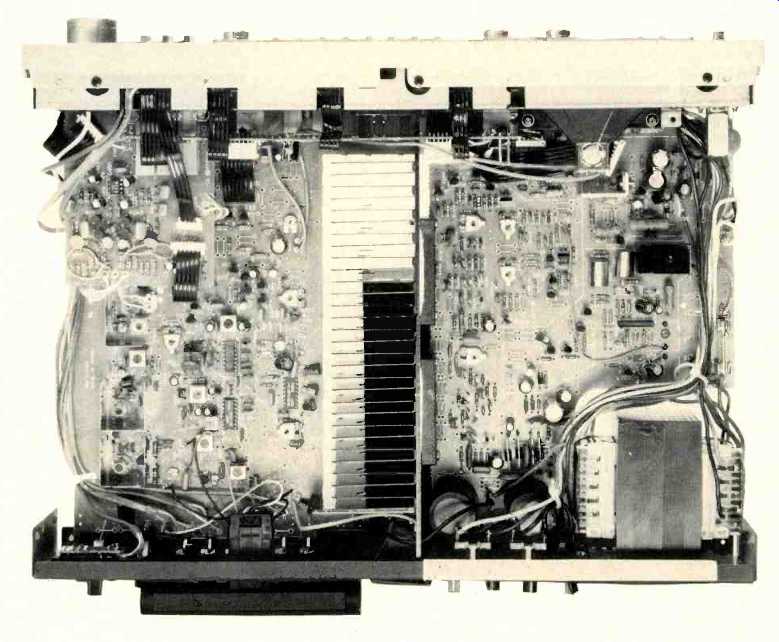
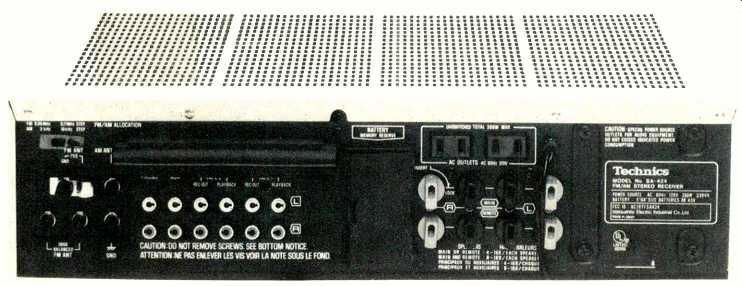
------------ This receiver is fairly small yet has enough sophisticated
control features to satisfy most audio enthusiasts.
The rear panel of the SA-424 receiver is equipped with novel speaker connection terminals, each of which has a relatively large hole into which speaker wire is easily inserted. The terminal is then given a simple quarter-turn clockwise, which action locks the wire in place and creates good electrical contact. It would be next to impossible to create any amplifier output short circuits when using these terminals. Above the speaker terminals are a pair of a.c. convenience outlets (one switched, the other unswitched), while to the left is a battery compartment designed to house three AA-size batteries which are needed to keep the station memory "alive" and to insure that the unit tunes to the station previously listened to after the unit has been turned off and turned on again. The usual tape input and output jacks, an AM ferrite built-in antenna stick, a ground terminal, and external FM and AM antenna terminals are located at the left end of the rear panel. Either 75-ohm or 300-ohm twin lead transmission line may be connected from the FM antenna to the receiver.
No technical information regarding circuitry is provided in the owner's manual (though the booklet does an adequate job of instructing even a neophyte user regarding correct installation and operation of the set), but I surmise from a notation on the front panel of the receiver that the amplifier section of the SA-424 uses the new Technics "New Class A" circuitry, a system which is said to offer the advantages of ultra-low distortion normally found in Class-A amplifiers (which never switch signals from one conducting transistor to another) together with the higher efficiency and lower thermal dissipation of Class-B amplifier designs. This circuitry probably accounts, in part, for the fact that Technics was able to keep the size of this receiver so small without encountering any thermal problems whatsoever.
Tuner Measurements
Usable sensitivity in mono FM measured 11.2 dBf (2.0 µV), close enough to the claimed 1.9 µV (10.8 dBf) so that the difference can be attributed to measurement equipment. In stereo, usable sensitivity measured 17.6 dBf (4.2 µV/300 ohms). The 50-dB quieting sensitivities measured 2.6 µV in mono and 37 µV in stereo (13.5 dBf and 39 dBf), both marginally better than claimed by Technics. Mono S/N measured 75 dB as claimed, while in stereo we measured a signal-to-noise ratio of 72 dB or fully 2 dB better than claimed. Mid-frequency harmonic distortion measured 0.15 percent in mono and was actually a bit better in stereo, with measured results of 0.11 percent. Quieting and mid-frequency distortion characteristics as a function of signal strength are shown in Fig. 1, while in Fig. 2 I have plotted harmonic distortion versus FM modulating audio frequency, for both mono and stereo reception.
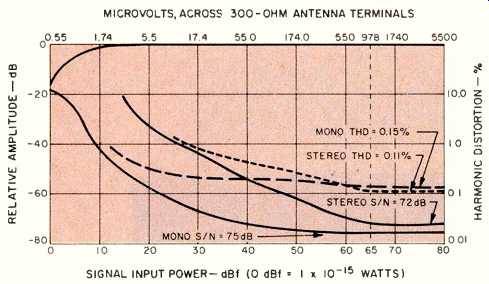
Fig. 1--Mono and stereo quieting and distortion characteristics.
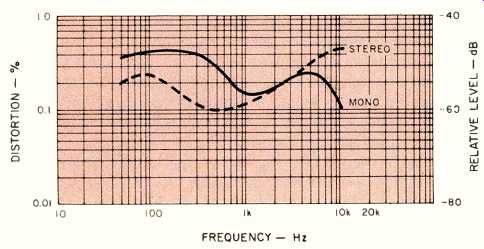
Fig. 2--THD vs. frequency, FM section.
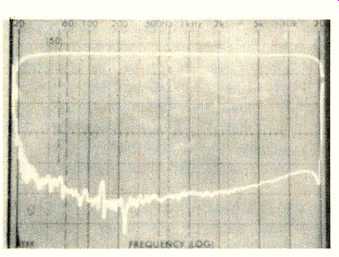
Fig. 3--Stereo FM frequency response, upper trace, and separation vs. frequency.
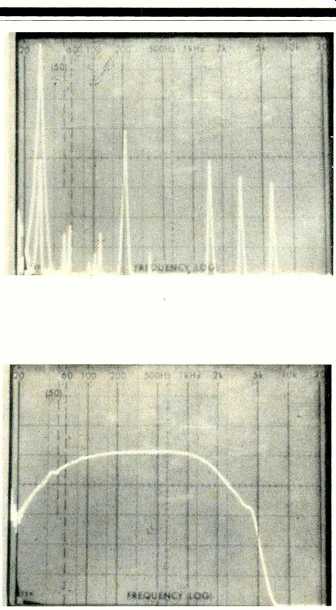
Fig. 4--Crosstalk components of 5 kHz, stereo FM section. Fig. 5-AM frequency
response.
Figure 3 is a 'scope photo of two composite frequency sweeps taken with a spectrum analyzer to show FM frequency response (upper trace) and stereo FM separation (lower trace).
The sweep is logarithmic from 20 Hz to 20 kHz and vertical sensitivity of the display is 10 dB per division. At the three specific frequencies which must be measured to be in conformity with the EIA/IEEE Tuner Standard, I read 47 dB separation at 1 kHz, 48 dB at 100 Hz, and 42 dB at 10 kHz--all significantly better than claimed by the manufacturer. The sweeps in the scope photo of Fig. 4 were made linearly and cover a frequency span from 0 to 50 kHz. These displays show the crosstalk components which occur when one channel is modulated with a 5-kHz signal (tall spike at left). Observations are then made at the output of the opposite channel and, relative to the 5-kHz reference signals, we see rather large amounts of 19 kHz, distortion components of the 5-kHz modulating tone, and residual amounts of 38 kHz and its sidebands (the three right-most spikes in the display). Referenced to under-emphasized low-frequency 100-percent modulating levels, subcarrier rejection levels met published specifications, but those claimed rejection figures are not especially good; if users intend to record "off the air" using this receiver they might do well to activate a MPX filter if such is available on their cassette recorders.
Selectivity measured exactly 75 dB as claimed, while AM suppression measured 56 dB. Image rejection was 57 dB; i.f. rejection measured 75 dB as claimed, and spurious rejection was 85 dB as against 82 dB claimed. Capture ratio measured 1.2 dB as claimed.
As is true of so many stereo receivers and tuners, the AM section of the SA-424 was basically of narrow-band design, as illustrated by the frequency response plot of Fig. 5 (plot is logarithmic, from 20 Hz to 20 kHz). Other published AM specifications were met or exceeded.
Amplifier Measurements
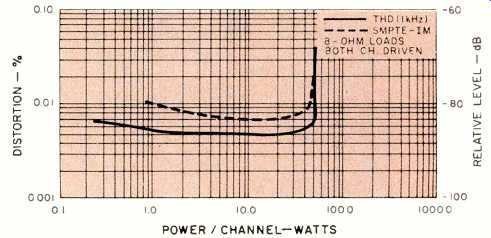
Fig. 6--Power output per channel vs. distortion.
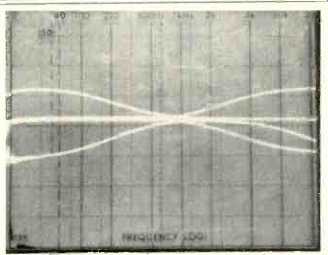
Fig. 7--Tone control range.
The power amplifier section of the SA-424 receiver easily delivered its rated power of 45 watts per channel at all audio frequencies within its stated power band. Technics claims an almost unmeasurable 0.007 percent THD as the rated distortion of this receiver and, as can be seen from Fig. 6, I did, indeed, measure even a bit lower than that for outputs of 45 watts per channel. SMPTE IM at rated output measured 0.1 percent, as claimed. THD levels were so low in this receiver that I found it difficult to come up with meaningful results at the audio frequency extremes. Indeed, Technics makes a point of the fact that the distortion of this receiver is so low that it had to be measured using a digital spectrum analyzer instead of a conventional distortion analyzer such as I use in my lab.
Perhaps part of the reason why this receiver, during subsequent listening tests, seemed far more powerful than its bench tests suggest is the rather high dynamic headroom of 2.4 dB measured for this sample. (Technics only claims a figure of 1.6 dB for this specification.) In effect, a dynamic headroom of 2.4 dB referenced to a rated output of 45 watts means that, under music signal conditions, this amplifier section could deliver short-term power peaks as high as 78.2 watts per channel with out significant clipping!
Damping factor, measured using a 50-Hz signal, measured exactly 40, as claimed (referred to an 8-ohm load). While this may seem to be a bit on the low side these days, it did not affect the quality of bass reproduction when the unit was auditioned and connected to my reference speaker systems.
The preamplifier and control sections of the receiver are well executed. Signal-to-noise in phono (80 dB, "A" weighted, referred to 5-mV input and 1.0-watt output) and for the high-level inputs (82 dB referred to 0.5-volt input and 1.0-watt output) are excellent figures for a unit of this type. Phono overload measured 150 millivolts at 1 kHz, well beyond the 130 mV claimed by Technics. Action and range of the bass and treble controls is pictured in Fig. 7. Action of the high-cut filter is also shown in this 'scope photo. Action of the subsonic filter begins below 30 Hz, and its effect is therefore not visible in the sweeps of Fig. 7, which only extends down to 20 Hz at the bass extreme. Meter measurements confirmed proper operation of this filter, however. I would have preferred to see a steeper slope for both the subsonic and high-cut filters, given a choice, since the 6 dB per octave slope provided only nominal attenuation of rumble and "hiss" frequencies.
Use and Listening Tests
The Technics SA-424 is a receiver whose front panel controls are easy to operate and with which the user will feel comfortable after only a few minutes of use. The tuning system used operated flawlessly, and the preset tuning memories are a worthwhile feature for anyone who listens to FM regularly. Level match, when switching from FM to records, was good, and the phono preamp section did a competent job of equalization and hum--free low-level amplification. Today's crop of popularly priced, relatively high-efficiency speakers are ideally suited to the power output level available from the Technics SA-424 receiver in typical home environments. As mentioned earlier, the receiver seems able to deliver power peaks that are audibly greater than its FTC power rating might imply.
Of course, there are instances in which a user might require more audio power than the SA-424 can provide, but in terms of its price, features, and performance, the Technics SA-424 is, to my way of thinking, a true bargain in today's audio component marketplace.
-Leonard Feldman
=================
(Adapted from Audio magazine, Aug. 1981)
Also see:
Technics SH-F1 01 FM Antenna (Aug. 1981)
Technics by Panasonic SA-8000X 4-Channel/2-Channel Receiver (Equip. Profile, Nov. 1974)
Technics by Panasonic Quadraphonic Tape Recorder Model RS-740US (Equip. Profile, Jul. 1973)
ULTRX R100 Receiver (Apr. 1985)
= = = =